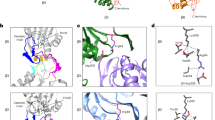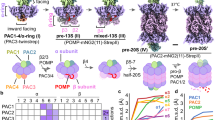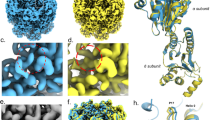Abstract
The 26S proteasome is an ATP-dependent dynamic 2.5 MDa protease that regulates numerous essential cellular functions through degradation of ubiquitinated substrates. Here we present a near-atomic-resolution cryo-EM map of the S. cerevisiae 26S proteasome in complex with ADP-AlFx. Our biochemical and structural data reveal that the proteasome-ADP-AlFx is in an activated state, displaying a distinct conformational configuration especially in the AAA-ATPase motor region. Noteworthy, this map demonstrates an asymmetric nucleotide binding pattern with four consecutive AAA-ATPase subunits bound with nucleotide. The remaining two subunits, Rpt2 and Rpt6, with empty or only partially occupied nucleotide pocket exhibit pronounced conformational changes in the AAA-ATPase ring, which may represent a collective result of allosteric cooperativity of all the AAA-ATPase subunits responding to ATP hydrolysis. This collective motion of Rpt2 and Rpt6 results in an elevation of their pore loops, which could play an important role in substrate processing of proteasome. Our data also imply that the nucleotide occupancy pattern could be related to the activation status of the complex. Moreover, the HbYX tail insertion may not be sufficient to maintain the gate opening of 20S core particle. Our results provide new insights into the mechanisms of nucleotide-driven allosteric cooperativity of the complex and of the substrate processing by the proteasome.
Similar content being viewed by others
Log in or create a free account to read this content
Gain free access to this article, as well as selected content from this journal and more on nature.com
or
References
Schwartz AL, Ciechanover A . Targeting proteins for destruction by the ubiquitin system: implications for human pathobiology. Annu Rev Pharmacol Toxicol 2009; 49:73–96.
Finley D . Recognition and processing of ubiquitin-protein conjugates by the proteasome. Annu Rev Biochem 2009; 78:477–513.
Goldberg AL . Nobel committee tags ubiquitin for distinction. Neuron 2005; 45:339–344.
Glickman MH, Ciechanover A . The ubiquitin-proteasome proteolytic pathway: destruction for the sake of construction. Physiol Rev 2002; 82:373–428.
Leroy E, Boyer R, Auburger G, et al. The ubiquitin pathway in Parkinson's disease. Nature 1998; 395:451–452.
Kish-Trier E, Hill CP . Structural Biology of the Proteasome. Annu Rev Biophys 2013; 42:29–49.
Voges D, Zwickl P, Baumeister W . The 26S proteasome: a molecular machine designed for controlled proteolysis. Annu Rev Biochem 1999; 68:1015–1068.
Saeki Y, Tanaka K . Assembly and function of the proteasome. Methods Mol Biol 2012; 832:315–337.
Peters JM, Cejka Z, Harris JR, Kleinschmidt JA, Baumeister W . Structural features of the 26 S proteasome complex. J Mol Biol 1993; 234:932–937.
Demartino GN, Gillette TG . Proteasomes: machines for all reasons. Cell 2007; 129:659–662.
Smith DM, Benaroudj N, Goldberg A . Proteasomes and their associated ATPases: a destructive combination. J Struct Biol 2006; 156:72–83.
Groll M, Bochtler M, Brandstetter H, Clausen T, Huber R . Molecular machines for protein degradation. Chembiochem 2005; 6:222–256.
Glickman MH, Rubin DM, Coux O, et al. A subcomplex of the proteasome regulatory particle required for ubiquitin-conjugate degradation and related to the COP9-signalosome and eIF3. Cell 1998; 94:615–623.
Sauer RT, Baker TA . AAA+ proteases: ATP-fueled machines of protein destruction. Annu Rev Biochem 2011; 80:587–612.
Djuranovic S, Hartmann MD, Habeck M, et al. Structure and activity of the N-terminal substrate recognition domains in proteasomal ATPases. Mol Cell 2009; 34:580–590.
Lander GC, Estrin E, Matyskiela ME, Bashore C, Nogales E, Martin A . Complete subunit architecture of the proteasome regulatory particle. Nature 2012; 482:186–191.
Matyskiela ME, Lander GC, Martin A . Conformational switching of the 26S proteasome enables substrate degradation. Nat Struct Mol Biol 2013; 20:781–788.
Unverdorben P, Beck F, Sledz P, et al. Deep classification of a large cryo-EM dataset defines the conformational landscape of the 26S proteasome. Proc Natl Acad Sci USA 2014; 111:5544–5549.
Hofmann K, Bucher P . The PCI domain: a common theme in three multiprotein complexes. Trends Biochem Sci 1998; 23:204–205.
Lasker K, Forster F, Bohn S, et al. Molecular architecture of the 26S proteasome holocomplex determined by an integrative approach. Proc Natl Acad Sci USA 2012; 109:1380–1387.
Beck F, Unverdorben P, Bohn S, et al. Near-atomic resolution structural model of the yeast 26S proteasome. Proc Natl Acad Sci USA 2012; 109:14870–14875.
da Fonseca PC, He J, Morris EP . Molecular model of the human 26S proteasome. Mol Cell 2012; 46:54–66.
Luan B, Huang X, Wu J, et al. Structure of an endogenous yeast 26S proteasome reveals two major conformational states. Proc Natl Acad Sci USA 2016; 113:2642–2647.
Estrin E, Lopez-Blanco JR, Chacon P, Martin A . Formation of an intricate helical bundle dictates the assembly of the 26S proteasome lid. Structure 2013; 21:1624–1635.
Verma R, Aravind L, Oania R, et al. Role of Rpn11 metalloprotease in deubiquitination and degradation by the 26S proteasome. Science 2002; 298:611–615.
vanNocker S, Sadis S, Rubin DM, et al. The multiubiquitin-chain-binding protein Mcb1 is a component of the 26S proteasome in Saccharomyces cerevisiae and plays a nonessential, substrate-specific role in protein turnover. Mol Cell Biol 1996; 16:6020–6028.
Sledz P, Unverdorben P, Beck F, et al. Structure of the 26S proteasome with ATP-γS bound provides insights into the mechanism of nucleotide-dependent substrate translocation. Proc Natl Acad Sci USA 2013; 110:7264–7269.
Bhattacharyya S, Yu H, Mim C, Matouschek A . Regulated protein turnover: snapshots of the proteasome in action. Nat Rev Mol Cell Biol 2014; 15:122–133.
Dambacher CM, Worden EJ, Herzik MA, Martin A, Lander GC . Atomic structure of the 26S proteasome lid reveals the mechanism of deubiquitinase inhibition. eLife 2016; 5:e13027.
Schweitzer A, Aufderheide A, Rudack T, et al. Structure of the human 26S proteasome at a resolution of 3.9 Å. Proc Natl Acad Sci USA 2016; 113:7816–7821.
Huang X, Luan B, Wu J, Shi Y . An atomic structure of the human 26S proteasome. Nat Struct Mol Biol 2016; 23:778–785.
Chen S, Wu J, Lu Y, et al. Structural basis for dynamic regulation of the human 26S proteasome. Proc Natl Acad Sci USA 2016; 113:12991–12996.
Liu CW, Li X, Thompson D, et al. ATP binding and ATP hydrolysis play distinct roles in the function of 26S proteasome. Mol Cell 2006; 24:39–50.
Chabre M . Aluminofluoride and beryllofluoride complexes: a new phosphate analogs in enzymology. Trends Biochem Sci 1990; 15:6–10.
Meyer AS, Gillespie JR, Walther D, Millet IS, Doniach S, Frydman J . Closing the folding chamber of the eukaryotic chaperonin requires the transition state of ATP hydrolysis. Cell 2003; 113:369–381.
Itsathitphaisarn O, Wing RA, Eliason WK, Wang J, Steitz TA . The hexameric helicase DnaB adopts a nonplanar conformation during translocation. Cell 2012; 151:267–277.
Choi WH, de Poot SA, Lee JH, et al. Open-gate mutants of the mammalian proteasome show enhanced ubiquitin-conjugate degradation. Nat Commun 2016; 7:10963.
Smith DM, Fraga H, Reis C, Kafri G, Goldberg AL . ATP binds to proteasomal ATPases in pairs with distinct functional effects, implying an ordered reaction cycle. Cell 2011; 144:526–538.
Lander GC, Martin A, Nogales E . The proteasome under the microscope: the regulatory particle in focus. Curr Opin Struct Biol 2013; 23:243–251.
Forster F, Unverdorben P, Sledz P, Baumeister W . Unveiling the long-held secrets of the 26S proteasome. Structure 2013; 21:1551–1562.
Asano S, Fukuda Y, Beck F, et al. Proteasomes. A molecular census of 26S proteasomes in intact neurons. Science 2015; 347:439–442.
Wang J, Song JJ, Franklin MC, et al. Crystal structures of the HslVU peptidase-ATPase complex reveal an ATP-dependent proteolysis mechanism. Structure 2001; 9:177–184.
Yamada-Inagawa T, Okuno T, Karata K, Yamanaka K, Ogura T . Conserved pore residues in the AAA protease FtsH are important for proteolysis and its coupling to ATP hydrolysis. J Biol Chem 2003; 278:50182–50187.
Finley D, Chen X, Walters KJ . Gates, channels, and switches: elements of the proteasome machine. Trends Biochem Sci 2016; 41:77–93.
Hersch GL, Burton RE, Bolon DN, Baker TA, Sauer RT . Asymmetric interactions of ATP with the AAA+ ClpX6 unfoldase: allosteric control of a protein machine. Cell 2005; 121:1017–1027.
Yakamavich JA, Baker TA, Sauer RT . Asymmetric nucleotide transactions of the HslUV protease. J Mol Biol 2008; 380:946–957.
Horwitz AA, Navon A, Groll M, Smith DM, Reis C, Goldberg AL . ATP-induced structural transitions in PAN, the proteasome-regulatory ATPase complex in Archaea. J Biol Chem 2007; 282:22921–22929.
Kim YC, Snoberger A, Schupp J, Smith DM . ATP binding to neighbouring subunits and intersubunit allosteric coupling underlie proteasomal ATPase function. Nat Commun 2015; 6:8520.
Stinson BM, Nager AR, Glynn SE, Schmitz KR, Baker TA, Sauer RT . Nucleotide binding and conformational switching in the hexameric ring of a AAA+ machine. Cell 2013; 153:628–639.
Glynn SE, Martin A, Nager AR, Baker TA, Sauer RT . Structures of asymmetric ClpX hexamers reveal nucleotide-dependent motions in a AAA+ protein-unfolding machine. Cell 2009; 139:744–756.
Smith DM, Chang SC, Park S, Finley D, Cheng Y, Goldberg AL . Docking of the proteasomal ATPases' carboxyl termini in the 20S proteasome's α ring opens the gate for substrate entry. Mol Cell 2007; 27:731–744.
Rabl J, Smith DM, Yu Y, Chang SC, Goldberg AL, Cheng Y . Mechanism of gate opening in the 20S proteasome by the proteasomal ATPases. Mol Cell 2008; 30:360–368.
Groll M, Ditzel L, Lowe J, et al. Structure of 20S proteasome from yeast at 2.4 Å resolution. Nature 1997; 386:463–471.
Forster F, Lasker K, Beck F, Nickell S, Sali A, Baumeister W . An atomic model AAA-ATPase/20S core particle sub-complex of the 26S proteasome. Biochem Biophys Res Commun 2009; 388:228–233.
Bech-Otschir D, Helfrich A, Enenkel C, et al. Polyubiquitin substrates allosterically activate their own degradation by the 26S proteasome. Nat Struct Mol Biol 2009; 16:219–225.
Prakash S, Tian L, Ratliff KS, Lehotzky RE, Matouschek A . An unstructured initiation site is required for efficient proteasome-mediated degradation. Nat Struct Mol Biol 2004; 11:830–837.
Beckwith R, Estrin E, Worden EJ, Martin A . Reconstitution of the 26S proteasome reveals functional asymmetries in its AAA+ unfoldase. Nat Struct Mol Biol 2013; 20:1164–1172.
Osmulski PA, Hochstrasser M, Gaczynska M . A tetrahedral transition state at the active sites of the 20S proteasome is coupled to opening of the α-ring channel. Structure 2009; 17:1137–1147.
Thomsen ND, Berger JM . Running in reverse: the structural basis for translocation polarity in hexameric helicases. Cell 2009; 139:523–534.
Rubin DM, Glickman MH, Larsen CN, Dhruvakumar S, Finley D . Active site mutants in the six regulatory particle ATPases reveal multiple roles for ATP in the proteasome. EMBO J 1998; 17:4909–4919.
Kohler A, Cascio P, Leggett DS, Woo KM, Goldberg AL, Finley D . The axial channel of the proteasome core particle is gated by the Rpt2 ATPase and controls both substrate entry and product release. Mol Cell 2001; 7:1143–1152.
Shi Y, Chen X, Elsasser S, et al. Rpn1 provides adjacent receptor sites for substrate binding and deubiquitination by the proteasome. Science 2016 Feb 19. doi: 10.1126/science.aad9421
Sone T, Saeki Y, Toh-e A, Yokosawa H . Sem1p is a novel subunit of the 26 S proteasome from Saccharomyces cerevisiae. J Biol Chem 2004; 279:28807–28816.
Verma R, Chen S, Feldman R, et al. Proteasomal proteomics: identification of nucleotide-sensitive proteasome-interacting proteins by mass spectrometric analysis of affinity-purified proteasomes. Mol Biol Cell 2000; 11:3425–3439.
Leggett DS, Glickman MH, Finley D . Purification of proteasomes, proteasome subcomplexes, and proteasome-associated proteins from budding yeast. Methods Mol Biol 2005; 301:57–70.
Hough R, Pratt G, Rechsteiner M . Purification of two high molecular weight proteases from rabbit reticulocyte lysate. J Biol Chem 1987; 262:8303–8313.
Mastronarde DN . Automated electron microscope tomography using robust prediction of specimen movements. J Struct Biol 2005; 152:36–51.
Li X, Mooney P, Zheng S, et al. Electron counting and beam-induced motion correction enable near-atomic-resolution single-particle cryo-EM. Nat Methods 2013; 10:584–590.
Scheres SH . RELION: implementation of a Bayesian approach to cryo-EM structure determination. J Struct Biol 2012; 180:519–530.
Mindell JA, Grigorieff N . Accurate determination of local defocus and specimen tilt in electron microscopy. J Struct Biol 2003; 142:334–347.
Ludtke SJ, Baldwin PR, Chiu W . EMAN: semiautomated software for high-resolution single-particle reconstructions. J Struct Biol 1999; 128:82–97.
Scheres SH . Beam-induced motion correction for sub-megadalton cryo-EM particles. eLife 2014; 3:e03665.
Kucukelbir A, Sigworth FJ, Tagare HD . Quantifying the local resolution of cryo-EM density maps. Nat Methods 2014; 11:63–65.
Emsley P, Cowtan K . Coot: model-building tools for molecular graphics. Acta Crystallogr D Biol Crystallogr 2004; 60:2126–2132.
Pettersen EF, Goddard TD, Huang CC, et al. UCSF Chimera — a visualization system for exploratory research and analysis. J Comput Chem 2004; 25:1605–1612.
Forster F, Villa E . Integration of cryo-EM with atomic and protein-protein interaction data. Methods Enzymol 2010; 483:47–72.
DiMaio F, Song Y, Li X, et al. Atomic-accuracy models from 4.5-Å cryo-electron microscopy data with density-guided iterative local refinement. Nat Methods 2015; 12:361–365.
Chen VB . Arendall WB 3rd, Headd JJ, et al. MolProbity: all-atom structure validation for macromolecular crystallography. Acta Crystallogr D Biol Crystallogr 2010; 66:12–21.
Adams PD, Afonine PV, Bunkoczi G, et al. PHENIX: a comprehensive Python-based system for macromolecular structure solution. Acta Crystallogr D Biol Crystallogr 2010; 66:213–221.
Zhang F, Hu M, Tian G, et al. Structural insights into the regulatory particle of the proteasome from Methanocaldococcus jannaschii. Mol Cell 2009; 34:473–484.
Krissinel E, Henrick K . Inference of macromolecular assemblies from crystalline state. J Mol Biol 2007; 372:774–797.
Acknowledgements
We thank Drs Jinqiu Zhou and Zhaocai Zhou (Institute of Biochemistry and Cell Biology, Shanghai) for their generous support. We thank Yingyi Zhang and Mi Cao from the Electron Microscopy facility and Min Xue from Data Base & Computation system at National Centre for Protein Science Shanghai (NCPSS) for their assistance with the EM instrument management and data storage and parallel computing. We are grateful to the NCPSS Protein Expression and Purification facility, Mass Spectrometry facility, and BL19U2 beamline at NCPSS and Shanghai Synchrotron Radiation Facility (SSRF) for instrument support and technical assistance. This work was supported by grants from the CAS Pilot Strategic Science and Technology Projects B (XDB08030201), the National Natural Science Foundation of China (31270771, 31670754), the National Basic Research Program of China (2013CB910401), the STS program of the CAS (KFJ-EW-STS-098), and the CAS-Shanghai Science Research Center (CAS-SSRC-YH-2015-01).
Author information
Authors and Affiliations
Corresponding author
Additional information
( Supplementary information is linked to the online version of the paper on the Cell Research website.)
Supplementary information
Supplementary information, Figure S1
Biochemical analyses of the yeast proteasome. (PDF 653 kb)
Supplementary information, Figure S2
Cryo-EM analysis of the proteasome. (PDF 1343 kb)
Supplementary information, Figure S3
Work flow for the processing of the high-resolution proteasome-ADP-AlFx cryo-EM data. (PDF 498 kb)
Supplementary information, Figure S4
Pseudo atomic models of proteasome 19S RP subunits fitted into the cryo-EM map of proteasome-ADP-AlFx. (PDF 653 kb)
Supplementary information, Figure S5
Cryo-EM maps of yeast proteasome in the presence of ATP and conformation comparison with related previous cryo-EM maps. (PDF 1084 kb)
Supplementary information, Figure S6
Conformation comparison of our proteasome-ADP-AlFx map with the previously reported cryo-EM proteasome maps. (PDF 826 kb)
Supplementary information, Figure S7
The AAA-ATPase ring conformational change between proteasome-ADP-AlFx and the resting state structures. (PDF 988 kb)
Supplementary information, Figure S8
AAA-ATPase subunit interaction interface analysis and conformational changes of the AAA-ATPase ring from proteasome-ATPγS to proteasome-ADP-AlFx. (PDF 774 kb)
Supplementary information, Figure S9
Conformational changes of the AAA-ATPase subunits from the substrate-engaged state to the ADP-AlFx state. (PDF 544 kb)
Supplementary information, Figure S10
Conformational changes of Rpn10 and Rpn11 between proteasome-ATPγS and proteasome-ADP-AlFx. (PDF 871 kb)
Supplementary information, Table S1
Statistics of cryo-EM data collection and refinement. (PDF 74 kb)
Supplementary information, Movie S1
Comparison of our proteasome-ADP-AlFx map with the previous proteasome structures confirms that our proteasome-ADP-AlFx adopted a new conformation. (MOV 21868 kb)
Supplementary information, Movie S2
Base region conformational changes between proteasome-ATPγS and proteasome-ADP-AlFx, revealing the most prominent difference to be for Rpt2 in the AAA-ATPase ring and the origin of the gaps next to Rpt2. (MOV 18840 kb)
Rights and permissions
About this article
Cite this article
Ding, Z., Fu, Z., Xu, C. et al. High-resolution cryo-EM structure of the proteasome in complex with ADP-AlFx. Cell Res 27, 373–385 (2017). https://doi.org/10.1038/cr.2017.12
Received:
Revised:
Accepted:
Published:
Issue date:
DOI: https://doi.org/10.1038/cr.2017.12
Keywords
This article is cited by
-
Mechanisms and regulation of substrate degradation by the 26S proteasome
Nature Reviews Molecular Cell Biology (2025)
-
DiffModeler: large macromolecular structure modeling for cryo-EM maps using a diffusion model
Nature Methods (2024)
-
ISG15 suppresses ovulation and female fertility by ISGylating ADAMTS1
Cell & Bioscience (2023)
-
Cryo-EM of mammalian PA28αβ-iCP immunoproteasome reveals a distinct mechanism of proteasome activation by PA28αβ
Nature Communications (2021)
-
The proteasome 19S cap and its ubiquitin receptors provide a versatile recognition platform for substrates
Nature Communications (2020)



